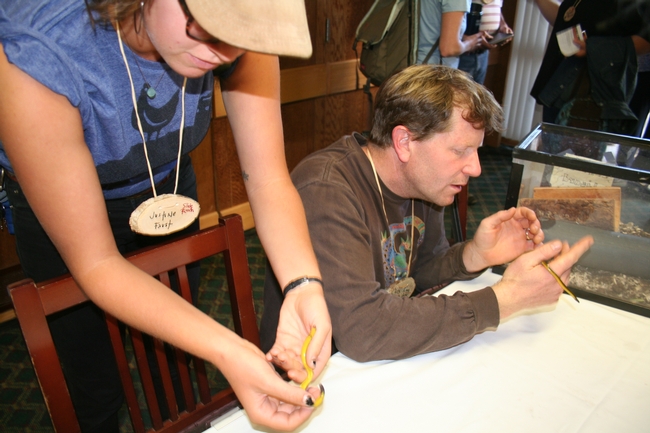
Similar scenes were repeated frequently during the three-day California Naturalist conference in October. The legless lizards and gopher snake brought in by a Fort Ord Dunes State Park ranger, a family of raccoons under the dining hall deck, deer browsing among the cottages and a beautiful sunset drew quick attention from participants. It is this enthusiasm that defines California Naturalists, a community with more than a love of nature, but a strong inclination toward gaining new knowledge, conserving the natural world and sharing their passion with others.
“We are in a room full of early adopters,” said Adina Merenlender to certified California Naturalists, instructors and aspiring naturalists at the conference. “It's amazing to see the seeds we planted growing into a real community. Everyone here has helped start this new community of practice.”

“This is exactly what we are doing,” said Merenlender, co-director of the California Naturalist statewide program and UC Cooperative Extension specialist in the Department of Environmental Science, Policy and Management at UC Berkeley.
At the conference, California Naturalists learned from world-class experts about engaging with nature and interpretation, coupling science and art, taking part in citizen science, preparing for global change, and protecting the state from invasive species. But perhaps the most important outcome was the opportunity for kindred spirits to share the weekend, forge lasting relationships and set future collaborations in motion.
“We're building a movement here,” said one of the conference speakers, nature writer and artist John Muir Laws. “We want to be strengthening ourselves. Our strength comes from the strands of the web between us.”
California Naturalists from around the state will reconvene in 2016. In the meantime, plans are being formulated to further develop the program, both in numbers and form, by reaching out to new audiences that will enhance the community of practice.

Sabrina Drill, co-director of the California Naturalist program and UC Cooperative Extension advisor in LA County, is reaching out to the Los Angeles Conservation Corps to see if the California Naturalist curriculum can be used to enrich the training now offered to young people enrolled in the program.
“The LACC participants learn important practical skills, like how to fell a tree and how to use a chain saw,” Drill said. “They have told me they would like to provide environmental background to participants so they learn why they are thinning forests and why they are removing invasive plants. We would provide them with the environmental science context.”
Another area where the California Naturalist program is poised to grow is with organizations that connect with regional, state and national parks.
“We can work with these groups to increase capacity in resource management at parks,” Merenlender said. “Government agencies can accomplish the nuts and bolts of local operations, but they can rarely provide the scientific and environmental literacy training for staff and volunteers.”
A third initiative aims to reach out to teachers. Drill and Merenlender are exploring a host of potential partnerships that can connect the California Naturalist community of practice to children, including UC's Project Learning Tree, the long-running Forestry Institute for Teachers, the San Jose Children's Discovery Museum, and the UCCE 4-H Youth Development program.
“If teachers take part in the California Naturalist program, they will bring what they learned back to the classroom,” Merenlender said. “As a community of practice, we are committed to helping our teachers ensure youth the environmental literacy intended by the increasingly popular slogan, ‘No child left inside.'”
For more information, see the California Naturalist website.